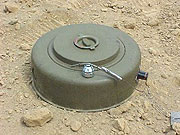Good news continues to come from and about Rwanda. This week it was officially announced that Rwanda was free of land mines. Land mines have been referred to as the silent killers but they may be called the blind killers because they do not different between its victims; a famer tilling his land, a child going to fetch water after school, a pregnant mother collecting firewood or food for children. The fact that Rwanda is mine free should be good news to all people.


Good news continues to come from and about Rwanda. This week it was officially announced that Rwanda was free of land mines. Land mines have been referred to as the silent killers but they may be called the blind killers because they do not different between its victims; a famer tilling his land, a child going to fetch water after school, a pregnant mother collecting firewood or food for children. The fact that Rwanda is mine free should be good news to all people.
A land mine is a small explosive device that when detonated sends small shrapnel into the victim. Land mines generally refer to devices specifically manufactured for this purpose. The use of land mines is controversial because they are indiscriminate weapons, harming soldier and civilian alike.
They remain dangerous after the conflict in which they were deployed has ended, killing and injuring civilians and rendering land impassable and unusable for decades. To make matters worse, many factions have not kept accurate records (or any at all) of the exact locations of their minefields, making removal efforts painstakingly slow. These facts pose serious difficulties in many developing nations where the presence of mines hampers resettlement, agriculture, and tourism.
Landmines come in various deadly packages. Also known as antipersonnel mines (AP), they are generally made to explode if stepped on. Larger anti-tank mines are designed to explode when driven over with vehicles. Further variations include booby traps, which can explode when a door is opened or an object (such as a toy) is picked up. Mines are often used to protect military sites from enemies.
However, mines are also used to demoralize populations by placing them near necessities like drinking water or agricultural land. Landmines kill 70% of their victims, about 10,000 deaths every year.
Of the survivors, half are severely injured with many needing limbs amputated. Beyond the physical damage there are many other consequences of landmines. Landmines limit access to areas by tourists, traders, medical teams or aid workers.
In addition, by mining farms or water sources, the risks of malnutrition and disease often increase greatly retarding development. Landmines not only kill or maim victims; they also affect the nearby communities.
During the war in Rwanda (1990-194 and the guerilla war waged by Interahamwe and defeated Ex-FAR) landmines were extensively used in Northern and Western Rwanda. In March 1992 Rwanda with the assistance of Boutros Boutros Ghali signed an agreement with Egypt to purchase arms worth $6 million. Rwanda was to pay $1 million cash within six months of the signing of the contract.
Another $1 million was to be paid by the delivery of 615 tons of Rwandan tea by the end of 1992. The remaining $4 million was scheduled to be repaid in annual instalments from February 1993 through February 1996.
In addition to the delivery of $1 million of Rwandan tea to Egypt as partial payment for the arms, Rwanda pledged its future tea harvests from the Mulindi tea plantation to Credit Lyonnais as collateral for the guarantee.
The first consignment of weapons, disguised as ‘relief materials’ was loaded at Cairo international airport and was flown to Kigali on 28 October 1992 in a Boeing 707 by the Egyptian airline ZAS at a cost of US$65,000 for the round trip.
The arms purchase included fifty 60mm and twenty 82mm mortars, with ten thousand high- explosive artillery shells; over six thousand high-explosive shells for 120mm mortars; two hundred kilograms of plastic explosives; at least four hundred and fifty Egyptian-made Kalashnikov automatic rifles; more than three million rounds of ammunition.
The two thousand landmines were most probably planted in Northern Rwanda. Rwanda made a $5.9 million arms purchase from South Africa and others from France, Belgium, gifts from Zaire and other sources which also included land mines.
Many of these were placed in minefields without marking and recording them for removal.
Whereas the placing and arming of landmines is relatively inexpensive and simple, the process of detecting and removing them is typically expensive, slow, and dangerous. This is especially true of irregular warfare where mines were used on an ad hoc basis in unmarked areas. Anti-personnel mines are most difficult to find, due to their small size and the fact that many are made almost entirely of non-metallic materials specifically to escape detection.
It is estimated that there 44.8 million land mines buried in 11 African countries, and by far the worst affected are Angola, Egypt and Mozambique. It is estimated that there are 15 million land mines in Angola, 1 million in Eritrea, Somalia and Sudan, 23 million in Egypt, 3 million in Mozambique.
South Africa and Egypt are Africa’s major producers and exporters of land mines. A treaty to prohibit the use, stockpiling, production, and transfer of anti-personnel mines referred to as the Ottawa Treaty. Rwanda became signatory to the convention in December 1998 when it was already in the process of destroying the land mines.
By 2005 Rwanda had destroyed over 600,000 anti-personnel landmines. This excluded unexploded ordinances like bombs, shells and other explosive leftovers of the wars.
The news that Rwanda is free of landmines should be good news to all Rwandans and friends of Rwanda. Rwandans can now farm, graze, and carry on their daily movements without fear of losing their limbs to explosives.
Email: ekaba2002@yahoo.com


